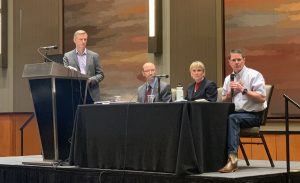Contents
RURAL HOSPITALS DISCOVER PANDEMIC SILVER LINING
HILL COUNTRY MEMORIAL HOSPITAL WINS TORCH LIGHT AWARD
5 TIPS FOR TALKING ABOUT COVID – 19 VACCINES WITH FRIENDS AND FAMILY
RURAL HOSPITALS DISCOVER PANDEMIC SILVER LINING
Panel of CEOs Identify 6 Great Outcomes from a Not-So-Great Year
by Brant Couch
“Rural medicine as a whole is in a much better place.”
This statement by Jeff Turner, CEO of Moore County Hospital District in Texas, was endorsed whole-heartedly by other hospital CEOs during a panel discussion at this year’s Spring Conference for the Texas Organization of Rural & Community Hospitals (TORCH).

I moderated the panel that also included CEOs Linda Walker of Val Verde Regional Medical Center, and Robbie Dewberry of Mitchell County Hospital.
While all agreed the “not-so-great year” isn’t actually over yet, they identified six areas where significant and sustainable progress has been made in response to the COVID crisis. The six areas are:
- Teamwork
- Community Connection
- Technology
- Innovation
- Post-COVID Revenue
- Collaboration
Teamwork
“I don’t know if I have ever been prouder of our team,” Robbie Dewberry said. “They just stepped up and took care of each other, took care of the patients, and the community trusted us to be able to take care of them.”
Linda Walker and Jeff Turner echoed the pride they felt as a result of their teams’ ability to step up and meet the crisis. Jeff described the progress made saying, “Our facility is now much more capable of handling complex patients. In the past, our nurses would have been scared stiff and we would have shipped them off.” Linda agreed, “Our nurses are the same way. You can say anything to them and they’ll say, ‘We’ve got this!’”
Like Linda and Jeff, Robbie is making sure these improvements are baked into the culture and capabilities of his hospital; “We are building this into our culture with protocols and cross training so that it is permanent.”
Community Connection
Speaking about how the “not-so-great year” has yet to end, Linda described how the connections forged between her hospital and other community leaders during the crisis are now playing an essential role.
“When everything hit last summer, the city and the hospital became true partners. The mayor, county judge, businesses, all advocated to help us get the PPE we needed. Throughout the summer, the community held us in high esteem as healthcare heroes. Now, we’ve pivoted. The sheriff, fire department, church youth groups are part of our vaccination mobilization crew. We’ve become one big family, there are no turf battles, we are all on the same turf together. Our bonds are stronger than ever. This will not dissipate.”
For Robbie, one essential element in nurturing the hospital’s relationship with the community is communication. “They want to know what is going on, they do not want sugar coating… this thing could have gone south in very quick order without the community support,” he said. Like his fellow panelists, Robbie and his team utilized all available means to ensure the community knew as much as possible about the situation at the hospital.
Linda, in particular, and out of necessity, took greater advantage of social media than in the past. “The newspaper in Del Rio closed at the beginning of COVID… it was our primary community outreach vehicle,” she said. “We had to get very agile with communicating so we got aggressive with Facebook and electronic bulletin boards around the area. One year later, we have become very good at communicating on Facebook – something is posted every day.”
Technology
When all beds are full, and people are afraid to come to the hospital for fear of contracting the virus, yet they need healthcare, what do you do?
For Jeff and his team at Moore County – and many other hospitals across the country, the answer was greater utilization of technology. “Virtual visits saved us during the pandemic because there was no other way to get these patients seen,” he said. They also ramped the use of remote patient monitoring, cardio monitoring, and other technologies.
At Mitchell County Hospital, Robbie and his team chose an alternative way to leverage technology. “We got creative with scheduling and screening patients; any suspicion of COVID and we scheduled the patient visit for after 3 p.m. We separated the visits very early on and used telemedicine to facilitate this.”
Linda’s team at Val Verde Regional had a wild ride because they had just implemented a new EHR system when the first wave of the COVID crisis swamped their hospital. “We went live on February first and the pandemic was declared on March third. Expediency required us to go ahead before the customary break-in period,” she said. “Perhaps it wasn’t the optimal debugging methodology, but it illustrates how quickly a team can adapt when they have to.”
What’s more, the hospital’s elderly and chronically ill patients, those most vulnerable, needed an alternative to a riskier visit to the hospital. “Instead of waiting 6 – 9 months to ramp up the remote patient monitoring module, when we realized how bad it was, we pivoted very quickly,” Linda said. Despite the pandemic, this helped Val Verde maintain and improve chronic disease management.
Innovation
Among the three panelists, several examples of innovation where discussed. Val Verde had the U.S. Army show up to help and Linda said it has made a significant impact on the capabilities, attitude and toughness of her hospital staff. “A pulmonologist from Walter Reed was there for six months – he wrote new protocols, care procedures,” she said. “It was a great learning experience for staff and providers. Having a war-time mentality was critically important during the crisis and will be essential in future crises.”
Innovation came from within the community for Jeff Turner at Moore County. “We were having trouble getting gowns. My wife is a seamstress and she rallied other seamstresses to make gowns out of shower curtains,” he said. A local high school student recorded the seamstresses at work and posted the video on You Tube. “All of a sudden we were getting requests for these patterns from all over the world,” Jeff said. “How often do you think seamstresses have a chance to be heroes?”
Post COVID Revenue
A study published by the Chartis Center for Rural Health on February 10, stated close to half of U.S. rural hospitals are operating in the red. The study’s analysis pegged the national median for outpatient revenue, as a percentage of total revenue, at 77%.
All three panelists acknowledged outpatient visits plummeted with the onset of the pandemic. While remote patient monitoring, telemedicine, and virtual visits filled some of the care gap, the revenue gap remains as one of the biggest challenges going forward. “RPM is sustainable as long as it is not trading an RPM visit for a clinic visit. That’s a bad trade,” Jeff Turner said. “We need to get them back in the clinic. No one will ever say a virtual visit should be compensated the same way as an actual visit.”
The question, “How will we do that?” is an ongoing challenge all three hospitals are dealing with.
Collaboration
Perhaps some answers to the post-COVID revenue challenge can be found in collaboration.
As the pandemic continues, and from its onset, all panelists agreed that collaboration with TORCH (Texas Organization of Rural & Community Hospitals) has been invaluable. Not only did TORCH step up to share resources, source supplies, and coordinate deliveries, the communication and support continues is especially appreciated.
Linda said, “TORCH was totally transparent in their communication with us.” And Robbie said, “The TORCH CEO Forum is a vehicle that will become more and more valuable.
As to the challenge to hospital revenues, collaboration has given rise to new opportunities like direct contracting with local employers as well as tertiary hospitals.
“Direct contracting is becoming increasingly important, particularly for where we will be sending our staff,” Robbie said. “It helps me when I know 65% is going to Hendrick (a large medical center in Abilene, TX). It helps me when I know the majority of my employees are going to one tertiary hospital partner for complex care in my region. With a direct contract I can now control costs, get better care and boost morale.”
“We have added another significant contract; it is a different model in terms of what it takes to be successful,” Jeff said about an employer contract. “It plays off many of the things we’ve talked about here. Beyond a single employer, we have to mobilize an entire population health strategy including Medicare population by ACO, population management by employer, and by clinical condition. All of these use the same tools and concepts the COVID crisis brought into sharp relief.”
Rural medicine as a whole is in a much better place
Post-COVID, the economic, financial, social, and political environment presents new – and some old – challenges to rural and community hospitals. For me, as moderator of this excellent panel, the number one insight, the silver lining around all the COVID storm clouds, is collaboration. Underlying all six of the areas discussed, never going it alone, has proven itself to be the essential ingredient to survival and success.
HILL COUNTRY MEMORIAL HOSPITAL WINS TORCH LIGHT AWARD
Risk Management Success Shines for Much Awarded Team
Jayne Pope, CEO is getting used to accepting awards on behalf of her high performing team at Hill Country Memorial Hospital in Fredericksburg, Texas.
As a long-time participant in Texas Organization of Rural & Community Hospitals (TORCH) insurance program, Hill Country Memorial was one of the three nominees selected for this year’s TORCH Light award by the TORCH insurance committee. The award is presented by the TORCH Insurance Program Manager, HealthSure.
HealthSure’s chair and founder, Barry Couch, recently visited the hospital to present the award to Pope and members of her team. “We select nominees from among all of the program participants based on their loyalty to the program, success in overall claims management, and their loss ratio,” Couch said. “Most importantly, we select nominees who are high performers in the essential areas of patient and staff safety, as well as overall risk and health risk management.”
“HealthSure has a bias for working with hospitals that would rather embrace risk and manage costs as much as possible rather than simply buy insurance from a carrier,” Couch said. “Instead of renting their insurance from year to year, they are taking control and turning risk into an asset.”
Asked why HealthSure nominated Hill Country Memorial, Couch said it was because of their willingness to assume and manage risk, and because of their proven ability to deliver superior patient quality and safety plus team professionalism and performance. “Hill Country Memorial deserves this award because it has maintained a low loss ratio for the 11 years they have been a member of the TORCH Insurance Program. Plus, they have a high loyalty factor and have earned the trust of the community and their peers.”
Hill Country Memorial Hospital is one of the longest-standing, highly awarded, independent community hospitals in Texas. Previous acknowledgements of the hospital’s performance include:
- Being named one of Becker’s top 100 Rural and Community hospitals this year
- And, a top 100 hospitals by Watson Health for over 8 years
- The Chartis Center for Rural Health Association top 100 rural hospital
- The Leapfrog Safety Grade “A” Rating from CareChex Medical Excellence
- The Bill Aston Award for Quality from Texas Hospital Association
- The Malcom Baldrige National Quality Award




